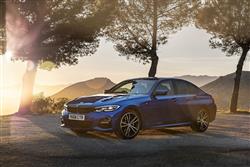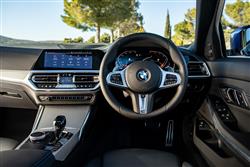THREE'S COMPANY (some text hidden) --NONE--
By Jonathan Crouch
Introductionword count: 79
The BMW 3 Series has ruled the compact part of the mid-sized executive segment for around half a century and, back in 2018, the company's hopes were high for this seventh generation 'G20'-era version. It was smarter, slightly larger, more efficient and considerably high-tech. All the things you'd expect really. Something else you'd expect from this model is rear wheel drive handling purity. It doesn't disappoint in that regard either. Let's check this car out as a used buy.
Modelsword count: 12
4dr saloon / 5dr Touring estate (318i,320i,330i / 318d,320d,330d / M3 Competition)
Historyword count: 487
Think of a really sharp handling relatively compact mid-sized sports saloon and it's probable that you're thinking of this car, BMW's 3 Series. Over more than four decades, it's dominated the segment it first invented and by 2018, upwards of 15 million of them had been sold. The Bavarian marque used to advertise every car it made as being 'the ultimate driving machine', but that hasn't been a slogan appropriate to many of the SUV-inspired or electrified models the company's brought us in more recent times. And it's also been a difficult mantra to meet as the 3 Series has become larger and heavier over the last few years. With this seventh generation 'G20' model, it was time for a re-set. Back in 2018, we wondered whether this 'G20'-series design would be good enough to provide it. BMW was determined that it would be. A clever new suspension system with 'lift-related' damping meant that the luxury ride this car needed to deliver didn't have to compromise the quest for the sharpest possible levels of handling. There were more responsive engines too, the strong selling diesels boosted by a switch from twin-scroll turbos to sequential twin-turbocharging that delivered extra mid-range engine punch. And the boast is that owners could have their cake and eat it because all the powerplants on offer were from the brand's latest 'Efficient Dynamics' family and claimed to offer class-leading cleanliness and frugality. That was something further aided by sleek aerodynamics and the lighter weight of the new CLAR platform that this contender borrowed from BMW's larger models. Actually in many respects, this was by 2018 one of the brand's larger models. For years following its original launch in 1975, this '3' was the entry point to BMW's range, but since the 1 Series hatch slotted in below it back in 2004, the 3 Series had been on a growth spurt, gaining more in size in its fifth and sixth generations than the previous four combined. Hence the needed change in descriptive terminology from 'compact' to 'mid-sized' executive saloon, justified in this G20 version by a rear cabin that at last on a 3 Series, claimed to be able to offer decently class-competitive levels of passenger space. Wherever you're sitting in this car, the Munich maker claims it'll feel properly luxurious, something previously only possible on mainstream models if you'd spent a fortune on extra cost options. From launch, G20 3 Series buyers were also promised safety upgrades, transmission improvements and key media system updates. It was the rejuvenated driving dynamics that many loyal BMW customers were keenest to put to the test. For the first time in a very long time, this promised to be a BMW that really would return the brand to the values it started out with. This 'G20'-series seventh generation 3 Series was subtly updated in mid-2022, but it's the earlier 2017-2021-era versions of it we look at here.
What You Getword count: 564
So what have we here? A 3 Series certainly, but one that's clearly evolved, both in style and size in both Saloon and Touring estate forms. This 'G20'-series seventh generation design is 85mm longer and 16mm wider than its predecessor and features a nose section dominated by a larger and much more imposing take on this car's familiar broad-framed kidney grille. From the side, you get a better feel for the extra 41mm of wheelbase that was added in this time round. And there's a cleaner, more modern look at the rear too, where surface contours flow into slim LED tail lamps featuring darkened lenses. Inside up front, for the first time in a 3 Series you're guaranteed the feel of a proper luxury car, even in the lower echelons of the range, surrounded as you are by widescreen, chrome-garnished expensively elegant cabin architecture. The media features will obviously be quite a talking point. The popular 'M Sport'-trim level gets you the brand's desirable full 'Live Cockpit Professional' package, which gives you a 12.3-inch virtual instrument binnacle screen and a 10.25-inch centre-dash iDrive monitor. There's some clever stuff incorporated into this pricier set-up, including gesture control and what BMW calls an 'Intelligent Personal Assistant', which works a bit like the 'Siri' or 'Google Assistant' systems you might use on your 'phone and is there to answer questions you can voice to the car as you drive it. Even the lesser 'Live Cockpit Plus' media package fitted with less trim packages gives you quite a lot, including 'Apple CarPlay' smartphone-mirroring, though original buyers only got that for a year before they had to pay for it. Many of the various 'ConnectedDrive' digital services were also life-limited before becoming chargeable. Finding the ideal driving position is easy, the redesigned seats are very comfortable and standard features like a rear view camera and a 'Park Assist' auto parking system make town driving easier too. In the rear, there's certainly more room to stretch out than was the case with the previous 'F30'-generation MK6 3 Series model, the distance between the front and rear seats extended by 11mm. There's slightly more headroom than before too and BMW claimed that the cabin was wide enough to take three child seats side by side, though only the two outside positions come with Isofix attachment points. You certainly get the kind of premium luxury feel you'd expect from the class above, particularly in a highly specified variant with classy stitched door card finishing and smart blue M flashing on the seat belts. And the boot? Well on a saloon variant, a powered boot lid came as part of the extra-cost 'Comfort' package but an electric tailgate was standard on the Touring estate version. Both include a 'hands-free' opening feature. The revealed trunk space on the sedan is the same size as it was before - 480-litres. That's the same as you'd get in an Audi A4 and an Alfa Romeo Giulia but 25-litres more than you'd get from a Mercedes C-Class from this era - or Jaguar XE. The Touring estate version serves up 500-litres, which was 5-litres more than the previous generation model thanks to a 112mm increase in cargo area width. That station wagon gained a rear window that opened separately, so smaller items became easier to load. You'll get a little less than that with the PHEV powertrain.
To see the full road test text contact us on 0330 0020 227
Pictures (high res disabled)
.jpg)
.jpg)
|
.jpg)
|
.jpg)
| |||
.jpg)
|
.jpg)
|
.jpg)
| |||

|
.jpg)
|

|
Scoring (subset of scores)
Category: Luxury Saloons and Estates
| Performance | |
| Handling | |
| Comfort | |
| Space | |
| Styling, Build, Value, Equipment, Depreciation, Handling, Insurance and Total scores are available with our full data feed. | |



